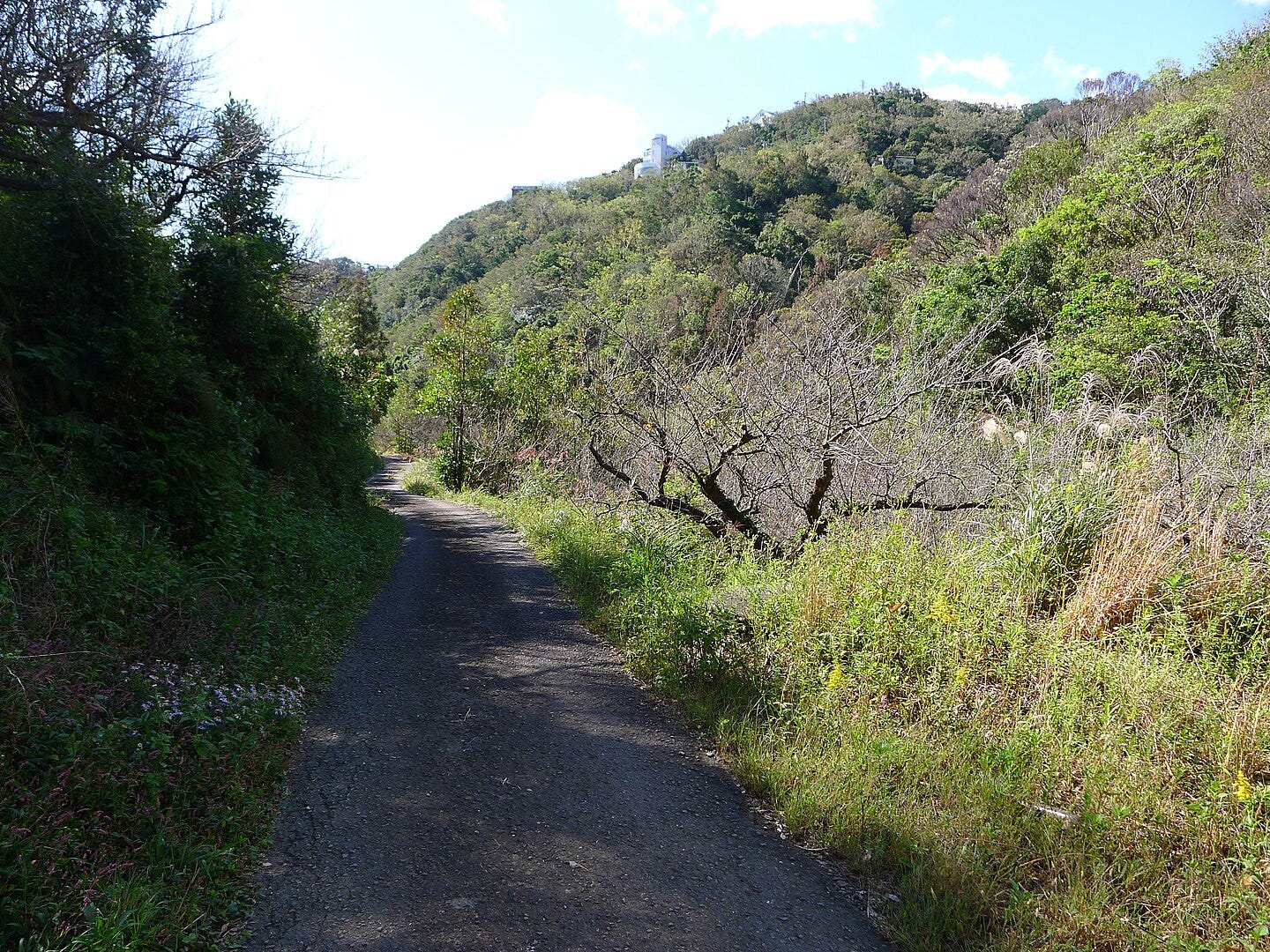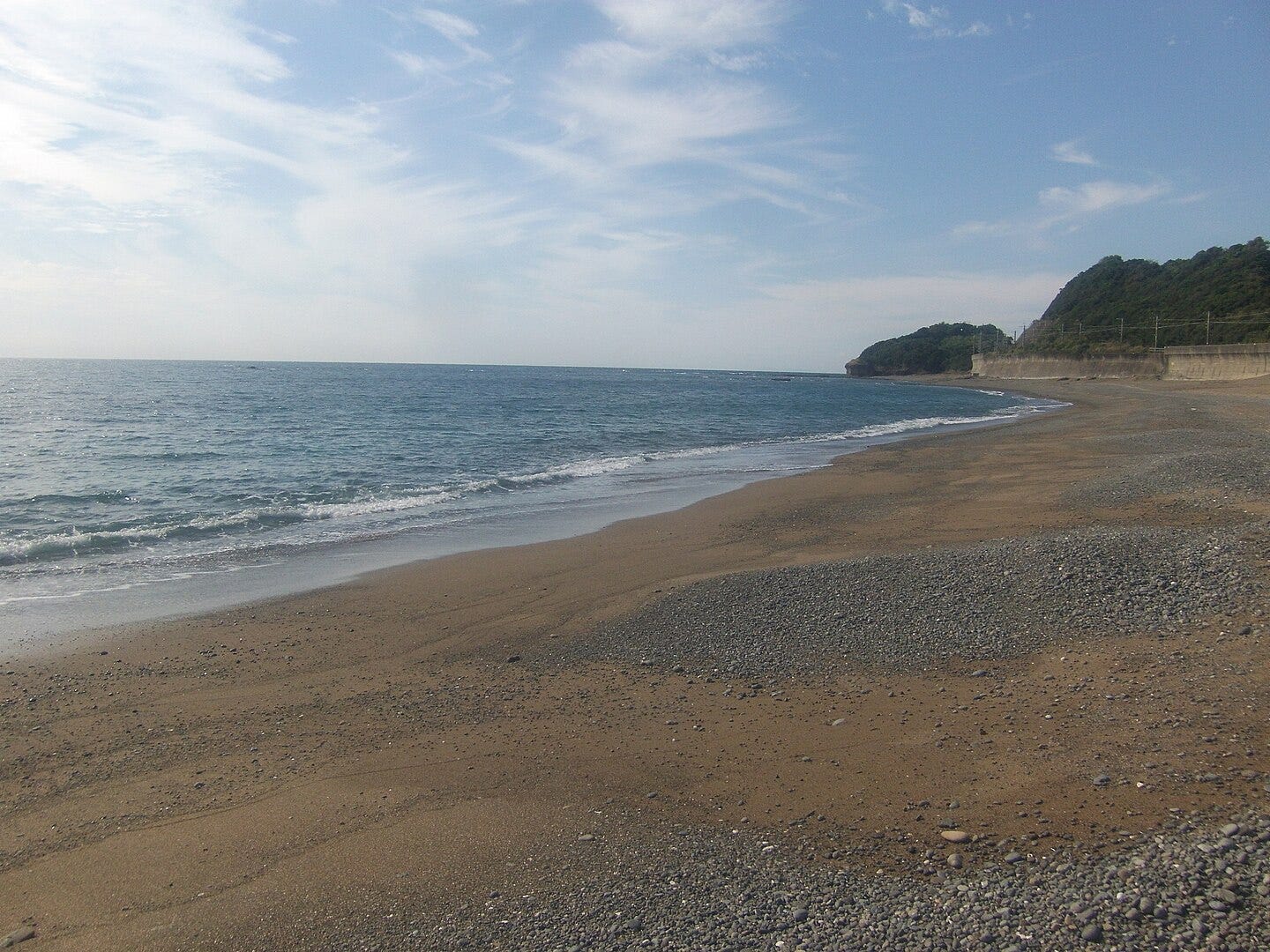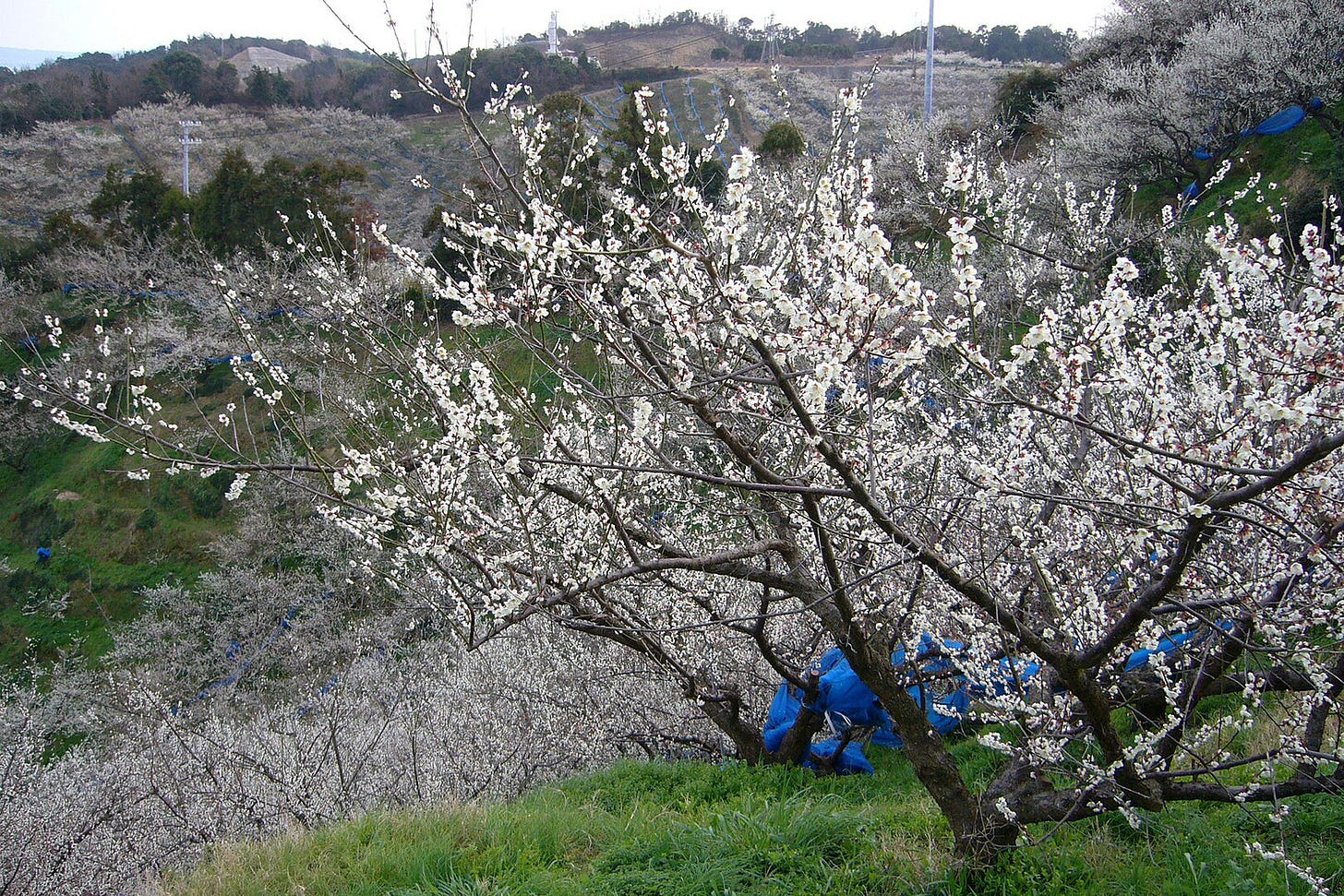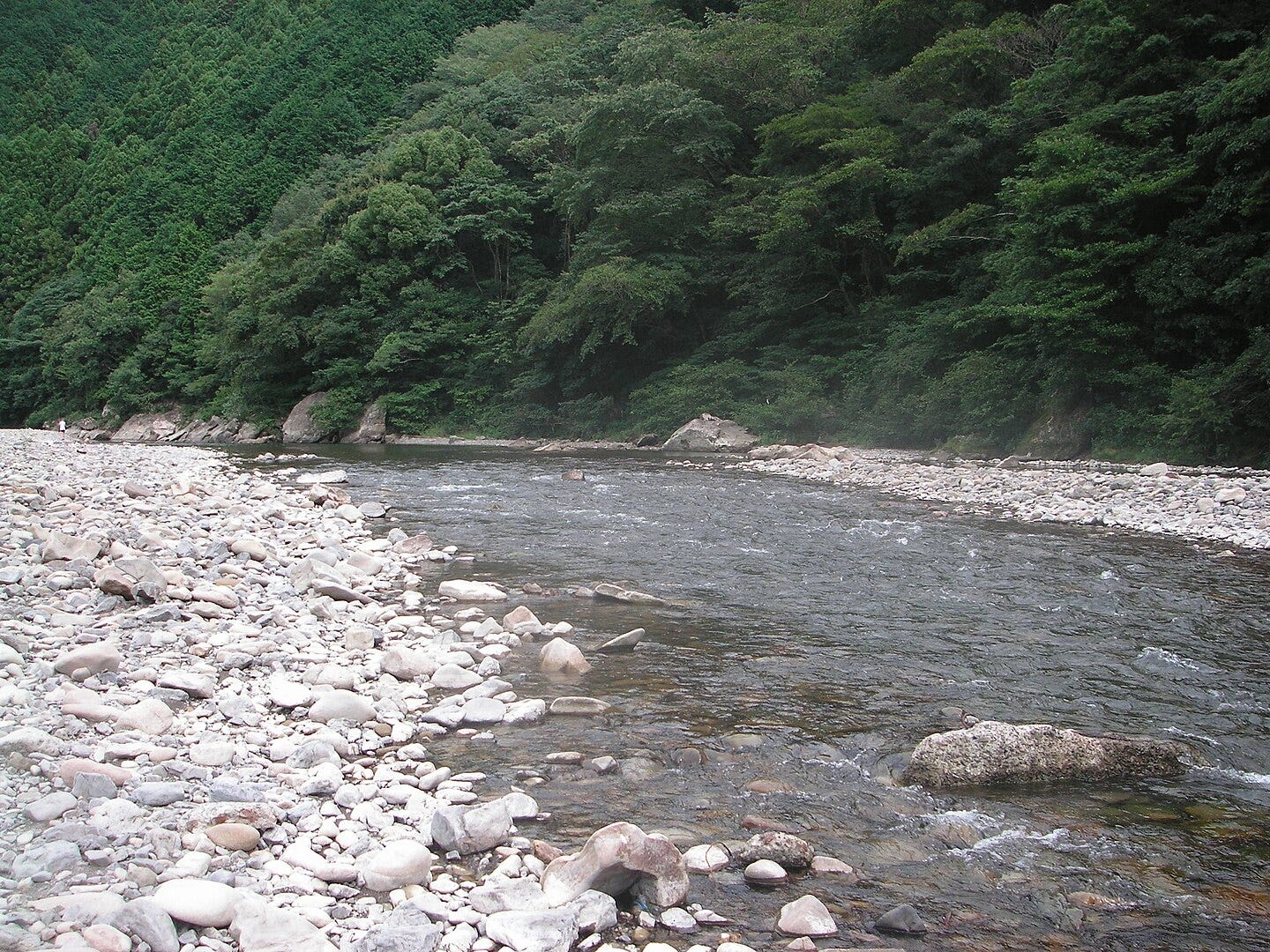Pine Branches and Slime Mould
Kirime to Kamitonda along the Kii-ji and Nakahechi routes of the Kumano Kodo
Nakayama Oji to Tanabe
It was cold enough that I no longer needed to shed my jacket. A biting wind blew in from the north and scattered pine branches across the courtyard at Nakayama Oji. The pilgrimage route had momentarily turned away from the sea, but now it twisted back towards it along an attractive valley where signs warned of snakes. The valley had an alpine air, lined with pine trees and pinewood chalets perched near the ridgelines. The sun shone in slanting rays on a choppy sea pierced by rocks like broken teeth.

My map was frequently tugged out of my hand by the wind sending me bounding and leaping like a March hare much to the amusement of some farming women. They laughed in their close broad bonnets and asked me where I was heading. “Kumano Kodo” I said. This brought more laughter, finger pointing of the direction I should take and commentary in a dialect too thick for me to understand.
Iwashiro and Senri-no-Hama beaches are frequently mentioned in classic poetry and storytelling. The most famous story attached to the place is that of Prince Arima, a true (but possibly embellished) story. In 658 CE, the crown prince, Naka-no-Oe led the government in a series of reforms, including moving the capital yet again to the more defensible site of Asuka, farther inland from Naniwa. Prince Arima plotted with Soga-no-Akae, a powerful member of the Soga clan put in charge of the new Futatsuki Palace in Asuka to seize power in a palace coup. Prince Arima was actually the eldest son of the previous Emperor Kōtoku, and so had a strong claim to the throne. However, Crown Prince Naka-no-Oe had a more powerful mother (who became Empress Saimei, with no Emperor), and so effectively became the Emperor. Crown Prince Naka-no-Oe’s pet project of building the large stone palace at Asuka required the construction of a canal to ship the stones from where they were quarried to Futatsuki. The canal and palace were of no benefit to the ordinary people, but required huge amounts of labour, resulting in popular dissatisfaction with the Crown Prince’s government. The time was ripe therefore for a palace coup, but Prince Arima was betrayed by Soga-no-Akae and escorted first to Shirahama hot springs, where the Empress and Crown Prince were staying, then up the coast towards Fujishiro on the outskirts of Kainan City, which I passed through earlier. At Fujishiro he was strangled.
As he went up the coast from Shirahama, he composed this poem on Iwashiro beach. The tying together of the pine brances symbolises tying the disparate pieces of one’s life together in an attempt to survive.
I draw and tie together
branches of the pine
on the beach at Iwashiro.
If all goes well
I shall return to see them again.

I marked the classical importance of the location by finding a place to take a leak in a tunnel of wind-distorted skinny trees and head-high reeds.
The oji at Senri-no-Hama was approached from the beach, a study in milk chocolate sand and pale grey pebbles. According to the Okagami (The Great Mirror, a historical tale covering the mid 9th to 11th centuries CE), the former Emperor Kazan fell ill on Senri-no-Hama beach and used a rock as a pillow. He must have been pretty ill to use one of these rocks as a pillow, I thought.
Though in an attractive location, there was not much to see at the shrine itself, so I pushed on towards Minabe, the nearest large town before I arrived at my current dwelling place of Tanabe. The path wiggled through a triangular railway no-man’s land where the line split before plunging one branch into a tunnel and balancing the other precariously along a cliff face. It was a wilderness of long grass, tattered signage and muddy paths.
The area around Minabe is famous for its plums. These are rarely eaten raw, but rather picked when still small and pickled. The results are jars of small wrinkled deep pink fruit which smell and taste rather like gooseberries and are called umeboshi. They are often used in bento packed lunches, placed in the middle of the rice to resemble the Japanese flag and not often eaten. Japanese love their regional specialities and it took me a while to figure out the resemblance of the smell when I passed the regional speciality shop in Tanabe daily on my way to work. It seemed so familiar, and finally it dawned on me, it smelled like gooseberries! My father had a passion for growing and eating the sourest fruit known to mankind. These fruit are sometimes neutralised in jam, but in full harvest season they are often put into pies. Gooseberry pies usually required the application of half a pot of sugar in order to bring the PH back up towards the 5 level. I was reminded of all this as I passed a multi-coloured umeboshi plant next to a river on the outskirts of Minabe.

Upon leaving Minabe another unfamiliar scent assaulted my nostrils. Again, it seemed so familiar, yet I couldn’t place it. The olfactory assault seemed to be coming from a factory overlooking the coast. I studied it for clues as to the smell. Having deciphered some kanji, I realised it was a recycling plant. The smell was rotting garbage. Such is the cleanliness of the average Japanese street and such is the efficiency of the rubbish collection system that the memory of this smell had been rendered redundant since leaving Old Blighty.
Haya Oji shrine was carpeted spectacularly with leaves of such stunning yellow that lemon zest sprang most readily to mind. I waited patiently for a family to have their photo taken with all the awkwardness of Japanese formality: semi-crouching sharp elbows with bobbing heads and low voiced apologies as the grandfather repeatedly cocked up the shot.
I entered my current dwelling place of Tanabe with a feeling of exaltation tinged with regret. The Kii-Ji was over. I would no longer be following the coast, but plunging inland, deep into the mountains, along the Nakahechi. So much of Japan faces the sea and so much of it is covered with mountains, but it is the plains where most people dwell. To truly visit this triumvirate of Japanese landscapes must surely be the aim, I felt, of any traveller to Japan.
And in this mood I went home.
Tanabe to Kamitonda
Just outside and hanging over my apartment, lay, in my biased opinion, one of the most beautiful temples in Japan — Kozanji Temple. On the day I moved into my apartment I visited the temple and was immediately taken by its pretty gardens and peaceful location. Not only is it aesthetically pleasing, it also has some important inanimate residents. Buried here are Ueshiba Morihei, the founder of Aikido, and Minakata Kumagusu, a naturalist with an interest in slime moulds so strong, he refused to leave a prison because he was having such a good time hunting slime moulds there.
A hard sun shone from a crisp blue sky as I set off with steaming breath along quiet roads. The first oji I passed was so insignificant I had to retrace my steps almost immediately to find the drably inscribed rock that marked its previous location.
I followed to the right a river called (again, according to my dubious translation) ‘the river that meets from the left’. Maybe the person who named it had been standing on one of the mountains behind Tanabe, rather than walking from the coast.
The still valley air was filled with the pneumatic hiss-click of mechanical pruners as farmers pruned back the plum trees in the brief time between plum collection, leaf dropping and flowering.
I went to look at the ruins of an ancient temple, and wished I hadn’t. There was nothing to see, grass grew among stones that marked the outline of the temple foundations. The detour caused excitement among the local children who followed me back down the road with cries of “harro!”
I climbed from the valley floor through silent farmyards where the frost still lay thick on the grass. I traversed from shaded south-facing slopes to bright sunlight across undulating wooded hills where big signs marked the route. The danger of getting lost was falling as I approached the more popular sections of the Kumano Kodo.
In a broad sunny valley I stopped on a bench to eat a convenience store lunch of various kinds of bread. A marathon was planned and the roads in the valley were scrawled with symbols to direct the runners.
I had to cross into the broader Tonda valley and there was no choice but to take the historically and aesthetically unpleasing option of passing through a roaring, fume-filled tunnel. I emerged at the other side to be confronted with a large withered tree trunk.
Beyond the tree trunk (a huge thing which had been swept downriver in a flood and now found itself a feature of interest in Kamitonda) I stopped again and rested at a pretty shrine where the former Emperor Gotoba had stopped in the autumn of 1201.
A map near the shrine showed a bridge nearby, but a brief, and then a more detailed scan of the river showed no bridge. I could only see some kind of pipeline crossing the river. Cursing Japanese cartography skills I pondered getting the bus back from here as there was a bus stop right next to the shrine. But instead I decided to walk along the riverbank a little way and see if the bridge wasn’t just around the next bend in the river.
The pipeline turned out to be the bridge. Japanese cartographers received a heartfelt, if silent, apology. The sides of the bridge were semi-circular metal tubes with the gap between them filled with concrete about a metre wide. There were no handrails. It seemed designed to achieve three purposes: one to allow pedestrians to cross the river without getting their feet wet, two to have a minimum lateral cross-section to reduce drag so the bridge wouldn’t be swept away in a flood, and third to cause innocent foreigners to assume it was actually a pipeline and consequently curse the cartographic skills of blameless Japanese map-makers.
Across the river I climbed high up above the valley floor, which was a pale yellow melded with the silver river and grey pebbles. The valley sides were a vivid green dabbed here and there with red and yellow. I imagined how I would paint this scene, which brushes I would use for the evergreen and deciduous trees and the simple palette of colours I could employ. High above tonbi kites soared, and then one fell, shrieking toward the valley floor. It wheeled sharply, now a spinning black speck far below. It seemed to miss its target, because soon it climbed back to its previous orbit with no sign of any prey.

I was paranoid about missing the last bus back to Tanabe. I knew there were few buses, especially on public holidays and there were probably few places to stay in this valley. It would be dark soon.
I found a bus stop, consulted the map and decided I could probably push on a bit further to the next stop on the map. I crossed the river again; the number of river crossings was deliberate — passing through the river water would help to purify pilgrims as they approached the most sacred area around the Sanzan.
I checked my progress against the map and turned back. I wasn’t sure I could make it to the next bus stop in time, so I returned to the previous stop, taking advantage of a hikers’ shelter next to the stop. In England the trickle of liquid running across the concrete floor to the door would have been urine or stale cola, and the neat racks of leaflets in the unattended shelter would surely have been vandalised.
Every day for nearly a year I had approached the high school where I was teaching by bus from the coast. Now it felt strange to be approaching it from the opposite direction and seeing what was beyond the school (cement works, houses, the usual Japanese semi-rural scene), I knew one side of it so well, and the other so little.





Another version out last week by Craig Mod "Things Become Other Things". Guessing you have crossed paths with Craig over the years, so will be interesting to hear your response to what sounds like a very personal journey. Cover could be better perhaps?
https://bookshop.org/p/books/things-become-other-things-a-memoir-craig-mod/21707235?utm_source=Klaviyo&utm_medium=campaign&utm_id=01JV7HKX237EWXCWFFB6A8J5X0&_kx=Zib0wE42ewHqKJ2rRiQwwCHh1hqyiN5S_W62s_ALdn3VnWZHr02VEwhAKC4GkdgD.U5D8ER
As usual, I loved all the funny asides.
Wakayama is one of those places I'd like to know better. I only passed through it in 2019 on my way to Shikoku.
How is it living in Tanabe? Do you miss the big city?